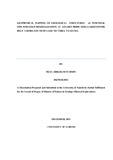Geophysical mapping of geological structures as potential Site for gold mineralization at golden pride nzega greenstone Belt tabora south of lake victoria tanzania

View/
Date
2013Author
Nkya, Abraham Tumsifu
Type
ThesisLanguage
enMetadata
Show full item recordAbstract
The study area is located southeast of Lake Victoria in Nzega greenstone belt Tanzania. It
represents inferred late Archean orogenic gold deposits and is hosted in intensely deformed metasedimentary
rocks. Nzega greenstone belt of the Nyanzian Super-group comprises felsic
volcanics, Banded Iron Formation (BIF), and subordinate mafic volcanics and sedimentary rocks.
Archean mineralization is hosted by BIF or felsic tuffs. Mineralisation is hosted within an eastwest
striking, steeply dipping, and brittle-ductile shear zone within a sequence of volcani-clastic
and siliclastic rocks of Archean age.
Aeromagnetic data are fully analyzed and interpreted where the analysis and interpretation are
mainly devoted towards outlining significant surface and subsurface tectonic trends and their
relationship with anomalous zones. According to the qualitative interpretation of the geological
and aeromagnetic data, shaded relief maps, upward continuation together with vertical derivatives,
analytical signals technique significantly improve the interpretation of magnetic data in terms of
discriminating between shallow and deep magnetic sources within the study area.
The lineament structural map is constructed through the signatures of the contours and shaded
relief of the total aeromagnetic data, analytical signal and horizontal derivatives. Euler deconvolution
was applied to the aeromagnetic anomaly map to delineate geologic contacts. The
depth estimates calculated for these major magnetic anomalies range between 1.6 and 2.1 km.
Lineament structural map and magnetic depth map values have been utilized to conduct the
interpretation of the main subsurface structures affecting the study area, which correlate with the
previous studies of aero radiometric anomalous zones all over the study area. The obtained results
show the most significant structural trends affecting the distribution of the anomalies in the present
study area.
Three main tectonic trends are outlined from the total aeromagnetic and shading relief maps. These
trends were defined as NE, NW and E-W; the prominent N-S trending fault identified from the
aeromagnetic data and also found on the surface geological map of the study area shows its
reactivation. These trends apparently control the distribution of gold mineral occurrence in the
area. Furthermore, most of the mineralization occurrences of Nzega greenstone belt have showed
an intimate association with interpreted high magnetic zones and lineaments. It is also evident that
lithological units affected by high lineament density have hosted some of the gold occurrences
Citation
Degree of Masters of Science in Geology (Mineral Exploration).Publisher
University of Nairobi
